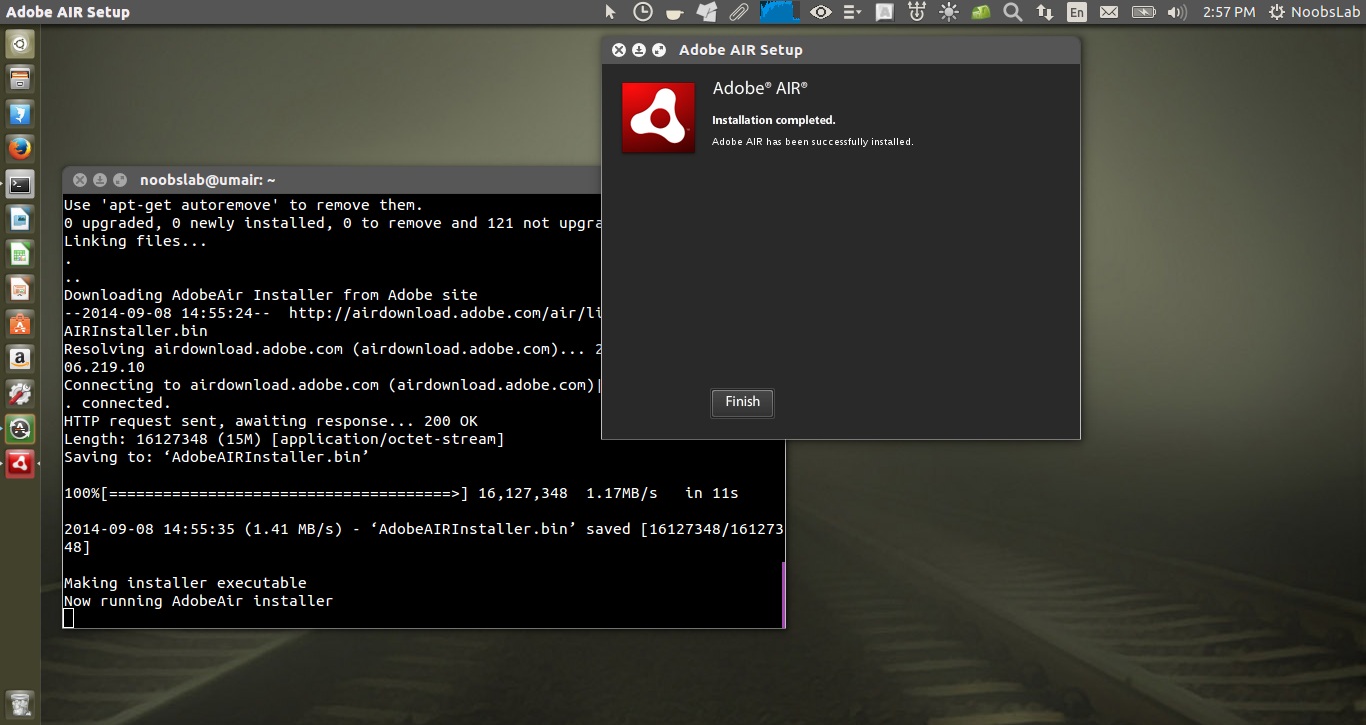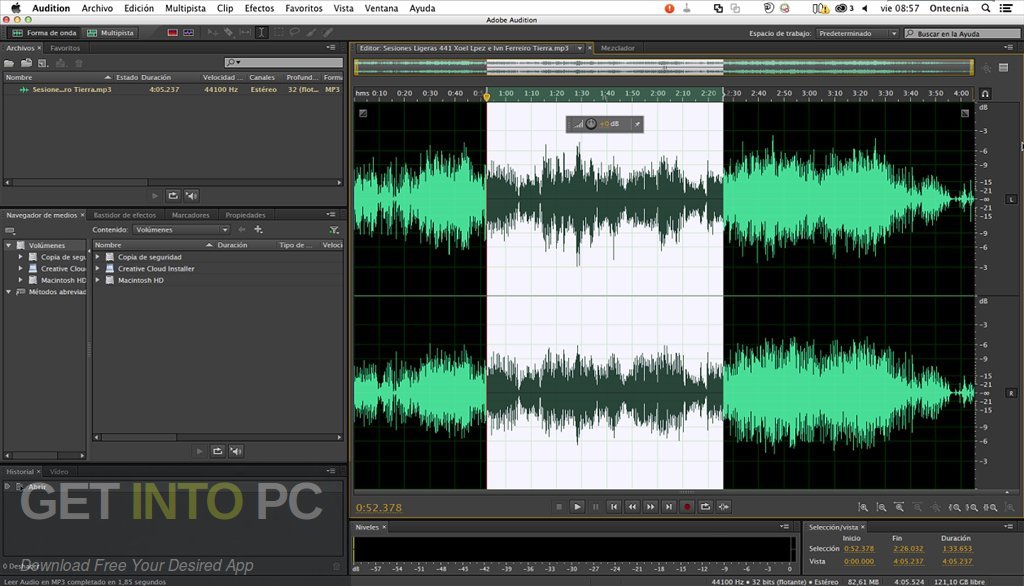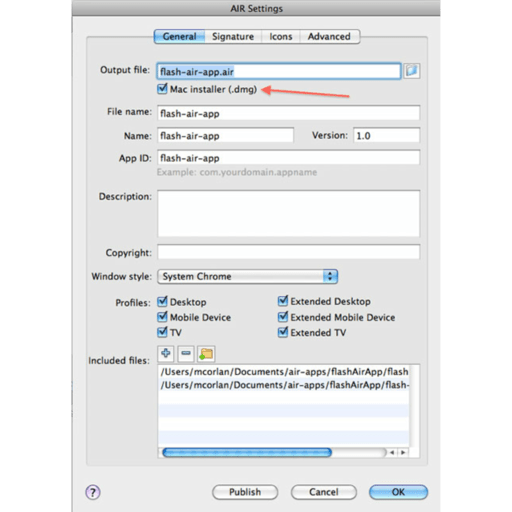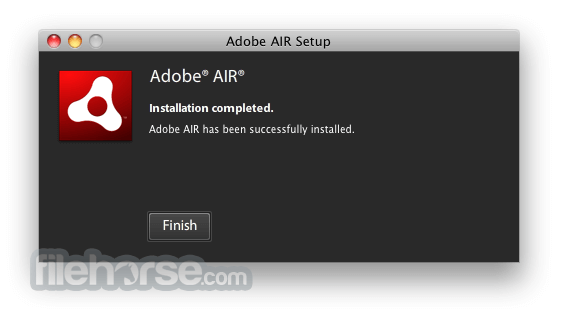Mac Operating system is the best platform for video editing and no wonder that many of the video editors use the mac systems to get their work done. There are a lot of other systems that get the same thing done. There are a lot of ways in which you can use the mac system for various purposes but video editing is a top priority for all the mac users.
- Download Adobe For Mac
- Install Adobe Air
- Adobe Air Installer Free Download For Mac
- Adobe Air Installer Windows 10
There are a lot of features that make the Mac system the perfect one to work on your video editing needs. The powerful processor behind the mac systems is what makes the mac operating systems a perfect fit for the usage of Adobe Premier Pro. There are a lot of features that makes the mac system top of its game.
License
Shareware
Adobe air doesn't install on new mac version StudioCloud. Explorer, Oct 11, 2019. Copy link to clipboard. If you have mac 10.15 you can't install adobe air. AIR stands for Adobe Integrated Runtime and it allows for the creation of great Internet apps that can be executed on a variety of platforms, including Windows, Linux, and Mac OS X. Adobe has a website full of published AIR apps which range from desktop FLV players, to clocks, converters, players, time, and resource management apps, among many. Select “Adobe AIR” to remove the runtime. Click the Change/Remove button. Remove the runtime on a Mac computer. Double-click the “Adobe AIR Uninstaller”, which is located in the /Applications/Utilities folder. Do one of the following: Select the “Adobe AIR Uninstaller” command from the Applications menu. Run the AIR installer. When I search for ADOBE AIR I find 'Adobe AIR Application Installer.app', 'Adobe AIR Uninstaller.app', and 'Adobe Flash Player Install Manager.app' in the Utilities folder. I don't find anything.
File Size
1.8GB
OS
Mac OS 10.12 or Later
Language
Multilingual
Developer
Adobe Inc.
Overview
The Adobe premiere pro is the best for video editing as it can make sure to tell the best content possible in all your videos. There are a lot of features that make the software a very good platform to express your talents and get things done. The advantage with the Adobe premier Pro compiled with mac operating system is the speed in which you can get the work done.
The biggest advantage with the software is the adaptability to pair with other devices where you can carry over the work that you left in the Mac desk.
1. Timeline tracking
Now the most important hurdle for any video editor is the ability to arrange his projects in line. With more video editing, it can grow pretty messy for the editor to sort out all his frames and projects on his computer. All this is avoided in the new Adobe Premiere Pro, where the software keeps track of all the online work projects maintained in a timeline to ensure that you focus on the most important ones first.
It is a boon to many of the video-editors as this ensures that all the works are completed on time and efficiently. This tool is just one of the key highlights that make the adaptability of Adobe Premier Pro top-class.

2. Integration at its best
When it comes to video editing, the sources that are taken from the computer files are many and this includes importing from other similar software to get better inputs. Most of the software that is into video editing do not have the ability to sync with other similar platforms, but not with Adobe Premiere Pro.
The integration of the software with other similar software from Adobe makes sure that you are equipped with everything that you would require to create a wonderful piece of video.
3. The much awaited-Premier Rush
Adobe premiere pro comes along with premier Rush. Premier Rush has been the much-awaited feature by the Adobe community. This feature enables the user to carry on their work on any devices that they have logged into with the Adobe account. You can carry on the pending work from a desktop to a laptop or any other device that could support Adobe Premiere Pro.
This gives the software a wonderful pathway to sync across devices and make sure you can extend your editing to any desired platform.
4. Automatic Reformatting
There are a lot of video editing tools that make the process of editing videos simple. But the biggest time-consuming part is rendering the video formats according to your output displays. This takes a lot of time to make sure that the video quality isn’t compromised in any format that it is displayed in. With auto-formatting on board, this time is saved. The software would auto-format the video to specific ratios to make sure that you can deliver projects regularly.
5. Adaptability to any format
There is the various format of videos that you can work within Abode Premiere Pro. The software supports videos from almost any device making the software flexible and easy to work with. you can edit the footage in any formats from HD to 4K quality, everything is covered in the software. This makes sure that you can take your work to any platform even in mobile workstations.
6. Audio mixing to the next level
Adobe Premiere Pro makes sure that editing sounds into your videos are at top-notch quality. There are a lot of ways in which you can tweak up the quality of sound in all your videos and make sure to bring down the active noise in your videos enhancing the richness in the sound as well. There are also various tools that will guide you through to make sure that the output sound is top-notch.
System Requirements for Downloading the Installer
- 16 GB RAM requirement
- 4GB of GPU RAM
- A processor that complies with dual-core processing 6th generation type
- 4GB of HDD storage
Download Adobe Premiere Pro 2019 Full Version for Mac OS with ISO
You can download the installer from the ISO river post from the link below. Make sure that the MAC systems comply with the minimum requirements before installation. The software is a delight to work with and also in terms of video editing makes it the best software to use.
Download Adobe Premiere Pro 2019 Full Version for Mac OS - ISORIVER

You can download the installer from the ISO river post from the link below. Make sure that the MAC systems comply with the minimum requirements before installation. The software is a delight to work with and also in terms of video editing makes it the best software to use.
Price Currency: USD

Operating System: Mac OS
Application Category: Video Editing
As of AIR 2, you can use ADT to create native application installers for distributing AIR applications. For example, you can build an EXE installer file for distribution of an AIR application on Windows. You can build a DMG installer file for distribution of an AIR application on Mac OS. In AIR 2.5 and AIR 2.6, you can build a DEB or RPM installer file for distribution of an AIR application on Linux.
Applications installed with a native application installer are known as extended desktop profile applications. You cannot use ADT to package a native installer for an AIR application if the application descriptor file does not support the desktop extended profile. You can restrict this profile using the supportedProfiles element in the application descriptor file. See Device profiles and supportedProfiles.
You can build a native installer version of the AIR application in two basic ways:
You can build the native installer based on the application descriptor file and other source files. (Other source files may include SWF files, HTML files, and other assets.)
You can build the native installer based on an AIR file or based on an AIRI file.
You must use ADT on the same operating system as that of the native installer file you want to generate. So, to create an EXE file for Windows, run ADT on Windows. To create a DMG file for Mac OS, run ADT on Mac OS. To create a DEB or RPG file for Linux, run ADT from the AIR 2.6 SDK on Linux.
When you create a native installer to distribute an AIR application, the application gains these capabilities:
- It can launch and interact with native processes, using the NativeProcess class. For details, see one of the following:
Communicating with native processes in AIR (for ActionScript developers)
Communicating with native processes in AIR (for HTML developers)
It can use native extensions.
It can use the File.openWithDefaultApplication() method to open any file with the default system application defined to open it, regardless of its file type. (There are restrictions on applications that are not installed with a native installer. For details, see the entry for the File.openWithDefaultApplication() entry in the language reference.)
However, when packaged as a native installer, the application loses some of the benefits of the AIR file format. A single file can no longer be distributed to all desktop computers. The built-in update function (as well as the updater framework) does not work.
When the user double-clicks the native installer file, it installs the AIR application. If the required version of Adobe AIR is not already installed on the machine, the installer downloads it from the network and installs it first. If there is no network connection from which to obtain the correct version of Adobe AIR (if necessary), installation fails. Also, the installation fails if the operating system is not supported in Adobe AIR 2.
Creating a native installer from the application source files
To build a native installer out of the source files for the application, use the -package command with the following syntax (on a single command line):
This syntax is similar to the syntax for packaging an AIR file (without a native installer). However there are a few differences:
You add the -target native option to the command. (If you specify -target air, then ADT generates an AIR file instead of a native installer file.)
You specify the target DMG or EXE file as the installer_file.
Optionally, on Windows you can add a second set of signing options, indicated as [WINDOWS_INSTALLER_SIGNING_OPTIONS] in the syntax listing. On Windows, in addition to signing the AIR file, you can sign the Windows Installer file. Use the same type of certificate and signing option syntax as you would for signing the AIR file (see ADT code signing options). You can use the same certificate to sign the AIR file and the installer file, or you can specify different certificates. When a user downloads a signed Windows Installer file from the web, Windows identifies the source of the file, based on the certificate.
For details on ADT options other than the -target option, see AIR Developer Tool (ADT).
The following example creates a DMG file (a native installer file for Mac OS):
The following example creates an EXE file (a native installer file for Windows):
The following example creates an EXE file and signs it:
Creating a native installer for an application that uses native extensions
You can build a native installer out of the source files for the application and the native extension packages that the application requires. Use the -package command with the following syntax (on a single command line):
This syntax is the same syntax used for packaging an a native installer, with two additional options. Use the -extdir extension-directory option to specify the directory that contains the ANE files (native extensions) that the application uses. Use the optional -migrate flag and MIGRATION_SIGNING_OPTIONS parameters to sign an update to an application with a migration signature, when the primary code-signing certificate is different certificate than the one used by the previous version. For more information see Signing an updated version of an AIR application.


For details on ADT options, see AIR Developer Tool (ADT).
The following example creates a DMG file (a native installer file for Mac OS) for an application that uses native extensions:
Creating a native installer from an AIR file or an AIRI file
You can use ADT to generate a native installer file based on an AIR file or an AIRI file. To build a native installer based on an AIR file, use the ADT -package command with the following syntax (on a single command line):
This syntax is similar to the syntax for creating a native installer based on the source files for the AIR application. However, there are a few differences:
As the source, you specify an AIR file, rather than an application descriptor file and other source files for the AIR application.
Do not specify signing options for the AIR file, as it is already signed
To build a native installer based on an AIRI file, use the ADT -package command with the following syntax (on a single command line):
Download Adobe For Mac
This syntax is similar to the syntax for creating a native installer based on an AIR file. However there are a few of differences:
Install Adobe Air
As the source, you specify an AIRI file.
You specify signing options for the target AIR application.
The following example creates a DMG file (a native installer file for Mac OS) based on an AIR file:
The following example creates an EXE file (a native installer file for Windows) based on an AIR file:
The following example creates an EXE file (based on an AIR file) and signs it:
The following example creates a DMG file (a native installer file for Mac OS) based on an AIRI file:
Adobe Air Installer Free Download For Mac
The following example creates an EXE file (a native installer file for Windows) based on an AIRI file:
Adobe Air Installer Windows 10
The following example creates an EXE file (based on an AIRI file) and signs it with both an AIR and a native Windows signature: